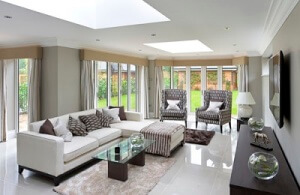 With a primary function of letting natural light into a building or structure, the rooflight’s role has evolved significantly in recent decades. Growing demands of Building Regulations and Government legislation mean that rooflights must now deliver a whole host of other requirements including; improving thermal performance, limiting heat loss and reduce demand on lighting, heating, cooling and ventilation systems.
With a primary function of letting natural light into a building or structure, the rooflight’s role has evolved significantly in recent decades. Growing demands of Building Regulations and Government legislation mean that rooflights must now deliver a whole host of other requirements including; improving thermal performance, limiting heat loss and reduce demand on lighting, heating, cooling and ventilation systems.
Historically, the introduction of rooflights into an existing building would have been avoided as glass would not provide the same level of insulation as opaque areas – thereby compromising thermal performance. However, research carried out by Oxford Brookes University and funded by the National Association of Rooflight Manufacturers (NARM) in 2006 fundamentally changed misconceptions about the role of rooflights in the overall energy efficiency of buildings. It demonstrated that the optimum level of rooflighting (in appropriate buildings) was 15-20% of the floor area.
Following this illuminating study, the industry body NARM has since gone on to publish a more recent report based on independent research carried out by Elmhurst Energy in 2014. The aim of this was to show that energy savings and carbon reductions can be made on existing UK industrial and commercial building stock by increasing the amount of natural light, improving lighting systems and adding automatic control of lighting systems.
Focusing on three different types of structures – an educational, industrial and retail building – the project was designed to explore the impact a number of improvement measures would have. Elmhurst Energy and NARM created a range of scenarios to apply to the existing buildings. These demonstrated how increasing the quality of daylight within buildings via rooflights and/or improving the existing lighting systems and controls would affect carbon emissions, costs and energy use.
In the retail building, a self-contained Homebase store with a total floor area of 3,930 m2, improvements to the rooflights and lighting controls would deliver a 29% reduction in carbon emissions while only 11% savings could be made by improving the electric lights and lighting control systems. In the 994 m2 industrial building, the same improvements would deliver a 23% and 14% reduction respectively whereas the school building’s results were far less positive.
A typical primary school, similar to a “CLASP” design which represents the majority of school buildings, would only see a 8.9% reduction in carbon emissions with the same improvements to the rooflights and lighting control systems. And improvements to electric lights and lighting controls would offer savings of just 3.7%. These results are significantly lower than the industrial and retail building, because only 51.4% of the floor area is in rooflit zones, so the improvements studied only affect about half of the total building.
Each building type shows significant savings in both running cost and carbon emissions can be achieved using a combination of improvements. With better insulated rooflights – such as the leak-free EcoGard from Lonsdale Metal Company – and better availability of natural light through the rooflights, the buildings can achieve the following reductions in use of the heating and lighting systems;
Type of building CO2 Emission Reduction Operating Costs Reduction
Homebase Store 24.1 kgCO2/m2/yr £5.20/m2/yr
Lunn Engineering 28.7 kgCO2/m2/yr £5.92/m2/yr
Ovingham School 7.3 kgCO2/m2/yr £1.50/m2/yr
The report summarises: “In all three example buildings, the effect of improving daylighting through rooflights (by a combination of using more efficient modern rooflights, fitted to an appropriate percentage of the floor area) in conjunction with the existing electric lighting system offers a significantly greater saving (typically twice as great a saving) than improving the efficiency of the electric lighting system in conjunction with the existing rooflights.”
Rooflights are often the only way of introducing natural daylight into many buildings and the benefits are clear to see. With ever more stringent Building Regulations and end users demanding better performing buildings, the construction industry is switching on to the numerous benefits of roof glazing systems.
When combined with modern lighting controls, the introduction of natural daylight through a high performance rooflight system can allow artificial lighting to be reduced or eliminated entirely – ensuring the building is not only energy efficient but offers an attractive and welcoming environment for its occupants.

